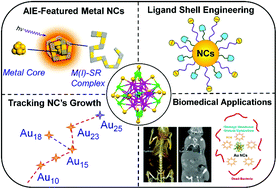Water-soluble metal nanoclusters: recent advances in molecular-level exploration and biomedical applications
Abstract
Water-soluble metal nanoclusters (MNCs) have received extraordinary attention in both fundamental and applied fields due to their ultrasmall size, unique molecular-like properties, rich surface chemistry, benign biocompatibility, and good stability. Currently, the state-of-the-art research on water-soluble MNCs has been upgraded from the nanoscale to the molecular level especially in the following aspects: (1) synthesis of highly luminescent MNCs featuring aggregation-induced emission (AIE), (2) Engineering the ligand shell of MNCs for controllable surface chemistry and (3) Tracking the reductive growth process of MNCs. Such molecular-level research progress of water-soluble MNCs in turn facilitated their development in biomedical applications. In this Frontier Article, we start our discussion by briefly summarizing the recent molecular-level research progress of water-soluble MNCs in the above-mentioned three aspects, followed by our perspectives on these fundamental aspects. Afterwards, the latest advance in biomedical applications of water-soluble MNCs is discussed. We hope that this Frontier Article could stimulate more studies on the molecular- or atomic-level understanding and biomedical applications of water-soluble MNCs.

- This article is part of the themed collection: 2019 Frontier and Perspective articles


 Please wait while we load your content...
Please wait while we load your content...